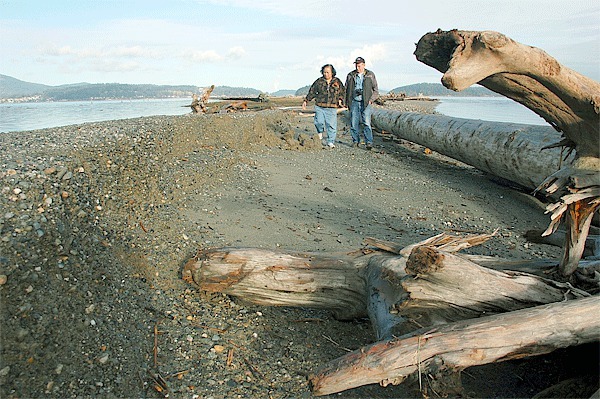A restoration project at Ala Spit is once again making waves with concerned North Whidbey residents.
Besieged with high tides and blustery winter conditions, a section of the spit the county spent nearly a month removing rip-rap from this past fall began to give way Wednesday, Nov. 23, when large amounts of newly placed sediment began washing into the adjacent estuary.
Brian Shelly, a park regular and Sleeper Road resident, was present when seawater began to carve paths through the spit and eventually spill over the top, carrying with it what he described as about two-thirds of the driftwood that was strategically placed along the beach as natural armoring.
“It was ridiculous and awesome both at the same time,” Shelly said.
But while many in the community, such as Shelly, are now shaking their heads and have come down with a case of the “I told you sos,” Island County Public Health officials and members of the department’s hired environmental consulting firm are breathing a sigh of relief as the project is unfolding just like it was supposed to.
“Everything going on out there is exactly what the science predicted,” Environmental Health Director Jill Wood said. “We’re in the beginning stages of the transformation that is restoration.”
The complicated and controversial project is several years in the making. The park was purchased in the 1990s and county officials quickly learned the neck of the spit near the parking lot was eroding.
County officials later hired a team of experts, Herrera Environmental Consultants, to examine the issue and the two-year study that followed determined that rip-rap — large boulders and crushed chunks of concrete — installed in the 1960s was the culprit. It prohibited the flow of sediment over the spit that occurred naturally during winter storms and high tides.
That material is believed to not only be vital for salmon habitat in the estuary but also served to strengthen the western, or lagoon side, of the spit. Based on those findings, the project was pitched to the public as a win for protecting long-term public access, restoring juvenile salmon habitat and controlling erosion.
In a September Whidbey News-Times story, just before construction efforts began, Wood addressed a wave of community concern about a possible breach and other potential problems, such as a washed-out parking lot, by saying that the project was preventative in nature. It is a “proactive” approach to making sure those kinds of things don’t happen, she said.
Shelly, who has questioned the science from the beginning, said watching nearly a foot of water flowing over about 100 feet of the spit last week did not make him a believer. If that much sediment washed into the lagoon after a moderately high tide, he said he can’t help but wonder what will happen later when waters rise even higher.
“Unless you have hip waders, you’ll have a hard time walking out there on a high tide,” Shelly said. Some of the year’s highest tides will occur over the Christmas weekend.
According to Jose Carrasquero, project manager for Herrera, getting your feet wet while trying to access the northern part of the spit on a high tide during winter is nothing new. While it wasn’t as extreme, and the rip-rap kept everything in place, it’s been happening for many years, he said.
He called public access a “tricky” component of the project, clarifying that the intent was never to create a wheelchair-accessible trail. He said the goal is and has always been to restore the spit to its original and natural state, which means there may be times when you have to hop a puddle or scale a few logs.
Carrasquero said the spit will reach a natural equilibrium and eventually stabilize into a landmass that will pretty much always be accessible to the general public. How fast that happens will depend on the severity and frequency of winter storms, so it could be the end of the season or years.
Carrasquero doesn’t live on Whidbey Island, but he said he’s been taking his family to Ala Spit for years and cares about the location and its well being. The work that was done was a good thing, but it will take some time to see the results.
“It’s like open heart surgery,” Carrasquero said. “Sometimes it looks ugly before its looks better.”
Shelly isn’t alone in his concerns. Many other community residents are worried that things will get worse and that access to the beloved park will be completely lost. However, Shelly said he’s willing to wait and see if the science behind the project holds up before casting final judgement.



